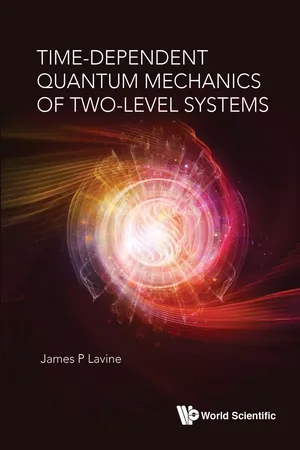
- 256 pages
- English
- ePUB (mobile friendly)
- Available on iOS & Android
Time-Dependent Quantum Mechanics of Two-Level Systems
About this book
With both industrial and teaching experience, the author explains the effects of time dependence in systems with two energy levels. The book starts with time-independent interactions and goes on to treat interactions with time-dependent electric and magnetic fields. Complete derivations are presented for each case, so the reader understands how the solutions are found. Both closed-form and numerical solutions are treated, and the calculations are compared with experimental data from the literature. Numerous plots are provided to show how the solutions depend on the parameters of the interactions.
The book builds upon an undergraduate course in quantum mechanics and is useful for readers interested in magnetic resonance and quantum optics. In addition, this book is ideal for self-study by students or researchers starting on two-level systems. The detailed derivations and plots should ease readers into the study of two-level systems in a wide variety of settings.
Contents:
- Preface
- Spin Precession and Rate Equations
- Two-Level Systems with a Time-Independent Interaction
- Two-Level Systems with a Time-Dependent Interaction
- Applications and Examples of Two-Level Systems
- The Density Matrix and the Relaxation of Two-Level Systems
- The Second-Order Correlation Function for Two-Level Systems
- Appendices:
- Physical Constants
- The Electromagnetic Field
- Diagonalization of a Matrix in Chapter 2
- The Time Evolution Operator and the Sudden Approximation
- Beyond the Rotating Wave Approximation
- The Second-Order Correlation Function for a Two-Level System
- References
- Index
Readership: This is an undergraduate textbook in quantum mechanics suitable for students in physics, chemistry, optics, materials science, and electrical engineering.
Key Features:
- The book starts at entry level and doesn't require knowledge in quantum mechanics
- Detailed derivations of the solutions and plots of the results
- Treats a wide range of time-dependent two-level problems. Closed-form solutions are provided for most cases; experimental data are included and compared to calculations
Frequently asked questions
- Essential is ideal for learners and professionals who enjoy exploring a wide range of subjects. Access the Essential Library with 800,000+ trusted titles and best-sellers across business, personal growth, and the humanities. Includes unlimited reading time and Standard Read Aloud voice.
- Complete: Perfect for advanced learners and researchers needing full, unrestricted access. Unlock 1.4M+ books across hundreds of subjects, including academic and specialized titles. The Complete Plan also includes advanced features like Premium Read Aloud and Research Assistant.
Please note we cannot support devices running on iOS 13 and Android 7 or earlier. Learn more about using the app.
Information
Chapter 1
Spin Precession and Rate Equations

1.1.Experiments and Time Dependence
Table of contents
- Cover
- Halftitle
- Series Editors
- Title
- Copyright
- Preface
- Contents
- 1 Spin Precession and Rate Equations
- 2 Two-Level Systems with a Time-Independent Interaction
- 3 Two-Level Systems with a Time-Dependent Interaction
- 4 Applications and Examples of Two-Level Systems
- 5 The Density Matrix and the Relaxation of Two-Level Systems
- 6 The Second-Order Correlation Function for Two-Level Systems
- Appendices
- Index